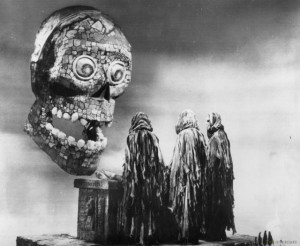 Jesse Wente on the Restoration of Canada’s First Horror and First 3D Film – The Mask Is Back to Haunt Us.
Jesse Wente on the Restoration of Canada’s First Horror and First 3D Film – The Mask Is Back to Haunt Us.
There was only one print of Julian Roffman’s influential 1961 3D horror film The Mask left in Canada in 2011 and it was deteriorating. Thanks to the passion of Jesse Wente, Director of Film Programmes at Toronto’s TIFF Bell Lightbox, the seminal tale of a mask that drives wearers mad, is back, baby and it looks great. We spoke with Wente in Toronto, where the film was shot but not set.
Opens Canada and the US Oct 23
The Mask also known as The Eyes of Hell is fun and it looks crisp and beautiful and it’s a real find. How did TIFF come to restore it?
We screened it on 35mm in 2011 as part of a global initiative audio visual heritage day and I was quite surprised at the time by the robust turnout. It sold out. Some people brought the original glasses from the sixties. The preservation folks who take care of the collections at TIFF informed me that it was the last time we could show the print. It was too worn. Every time you put a print through a projector the colours fade a little bit due to exposure and it becomes brittle and the reality is that it was the only 35 mm print that existed in Canada.
I couldn’t let that happen. It sparked me. The starting point for preservation globally was the idea that people should be able to see the movie. No one had heard of it outside the Canadian film industry because people weren’t able to see it. It wasn’t going to be restored as Goin’ Down the Road, The Rowdyman were, these foundational films of English Canadian cinema. They were more available to be seen than The Mask. We were lucky working with the 3-D Film Archive on the restoration and Technicolour folks in Canada. I’m very proud – it’s as good if not better than it was.
How is 3D film restored?
A big part is cleaning up the image, which is done digitally. The biggest challenge for the 3D segments is dealing with convergence which is where the left and right eye images converge into one, which creates the 3D. It’s a very difficult process. We were lucky that a year into our own restoration, researching to get better different materials – we wanted to get the most complete film the closets to Julian Roffman’s vision in 1961. We knew our materials were missing so it really was the cinema gods smiling down on us that we connected with 3D film archives. We had stuff they were missing and they had stuff we were missing. Their expertise in digitally restoring film from that era together with us, we couldn’t have done it alone. And we made the most complete version of the film possible.
I didn’t find the film terrifying given what we’ve seen since 1961, but it’s a great character drama.
I still find it scary especially in comparison to similar movies of its time. It’s a movie that is clearly an outgrowth of the 50s B genre pictures from Hollywood, 3D or not and it owes a nod to William Castle and the experience films like The Tingler and Smell-O-Vision. I find it fascinating. It’s not a joke, its intended to scare you. It sustains the horror better than many of its contemporaries and certainly better than gimmick movies.
What’s interesting is that it is very much in keeping with what is now identified with the legacy of horror movies in Canada. Horror movies were very important; David Cronenberg’s films and the tax-shelter films were all horror. It helped generate a real industry.
I look at the artistry in the film, and it’s the same as with David Cronenberg’s. People protested Cronenberg’s horror films claiming they were “ridiculous” exploitation films. Today he is the most prominent filmmaker in Canada ever. The Mask predates that by a decade.
So The Mask was the seed of the movement?
It’s fascinating, a pie-in-the-sky idea but now that The Mask has been restored and people can sit in a theatre see it and they can be involved in the discussion, not just horror but the idea of English Canadian horror
It’s great to see parts of Toronto like Convocation Hall and Rosedale in 1961 and interiors in the old Kleinberg Studios.
For sure. The film is designed not to be Toronto in order to sell internationally unlike The Rowdyman or Goin’ Down the Road or the Quebec films. It really had no interest and it opened in theatres in other countries.
But maybe it is an identity film. Maybe it does inform our understanding of horror films and leads to Cronenberg films. Cronenberg isn’t that unusual and didn’t exist in a total bubble. And all this conversation around Canadian horror. What we have there is something innately Canadian, the way the Canadian artist views the world. In tune with what’s in the shadows. Maybe it’s our long winter.